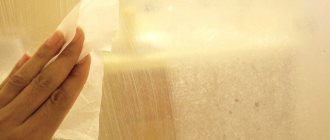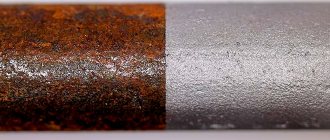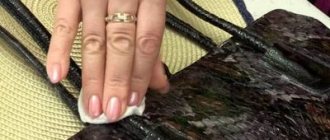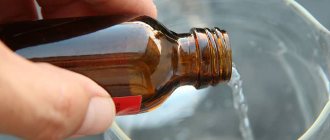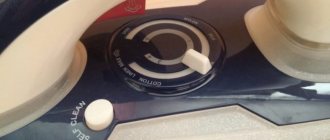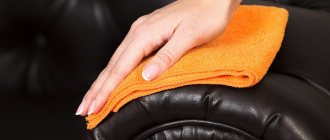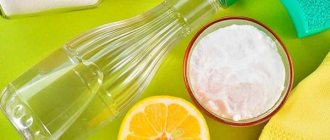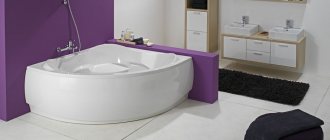In life, you often have to deal with solving non-trivial problems. You have to figure out, for example, how to polish a badge on a soldier’s belt to a shine or put in order a fairly tarnished horn. Sometimes it becomes necessary to polish Soviet-era copper coins. Perhaps for this you will need to look for a hardware store or friends among conscripts. The cleaning product can be purchased in the online store. But you can try to prepare an analogue of asidol with your own hands.
What is Asidol and why is it needed?
This is a cleaning agent that is used to clean various metal products (most often nickel and copper). But this cleaning agent is prohibited from cleaning products made of aluminum and painted to resemble other metals. This product is a white liquid.
Composition of the cleaning product
The composition of the purchased drug includes such chemical components as:
- carboxylic acid;
- mineral oils;
- sodium salts of naphthenic acids;
- surface active elements;
- abrasives that do not harm the human body;
- ammonia;
- wax of synthetic origin.
Application of Asidol M
This type of household chemicals is popular among soldiers undergoing military service and among the military; This product is used to clean the plaque on a military belt. This product was made at the beginning of the last century. There are several variants of asidol, which are classified according to their intended use.
Paste marked 4 is used in cases where it is necessary to rub out a scratch on the metal and give the surface of the product a matte tint. This type of paste is used to clean the fireplace grate. Paste marked 3 processes a thinner metal product. To make the product shine like a mirror, use paste marked 1 and 2.
This product is used mainly for polishing items made of non-ferrous metals, for cleaning chrome-plated and nickel-plated items, and is suitable for removing dirt and darkening of jewelry made of precious metals.
Coin cleaner Asidol M is used by collectors of various coins. Only this paste is capable of cleaning and maintaining the collection in good condition without causing harm; it allows you to polish even minor scratches, but only on coins made of silver-colored metal.
Application of Asidol-M
"Asidol-M" is a more modern means for cleaning metals and alloys. It is made from waste treated with sulfuric acid after purifying petroleum distillates with alkali. This drug has a pungent odor due to the active additives present in the composition, so it is better to use the product in a ventilated area. Before starting work, you must put on gloves on your hands.
The algorithm is simple:
- Before processing, shake the bottle with the product.
- We apply “Asidol-M” directly to the product that is intended for cleaning (unlike GOI paste, which must be applied to a cloth, dry or moistened with gasoline). The product must be dry. This also applies to GOI paste, but especially Asidol-M.
- We wait 1 minute until the active substances in the preparation act, dissolving contaminants and oxide film.
- Polish with a clean cloth or soft brush. Wipe dry.
How to clean a soldier's badge with Asidol?
Cleaning the plaque is a kind of soldier’s ritual, to which a large amount of time and effort is devoted. The use of Asidol paste does not harm the product and brings the desired result. To clean this item, you must follow these instructions:
- Before the procedure, you should carefully inspect the belt; If there are scratches on the fastener, it is better to sand them down first, since if the paste gets into the grooves, it can give the product a greenish tint.
- Take a small piece of natural felt and a small amount of paste.
- To clean the plaque, apply the composition to a felt flap in a small amount.
- Start rubbing the belt buckle with sanding movements until the scratches are removed, and then until completely clean.
- The procedure will be completed when you can see your reflection in the plaque, which is an extremely important indicator in the army.
Propylene glycol
This is also alcohol. It is popular in medicine, the food industry, and the cosmetics industry. Since this type of alcohol does not have a clear bactericidal effect, it is not added to antiseptics to combat microbes. It is used as a solvent, allowing the various components of the antiseptic to be mixed together.
For information
There are a large number of varieties of alcohols, differing in their structure and properties. For example, ethanol has pronounced antibacterial properties, and glycerin (this is also an alcohol!) has little effect on microbes, but moisturizes the skin well.
– Propylene glycol is approved for use in most countries of the world, since it does not have a toxic effect, including when ingested. In the food industry, the composition of products is designated as E1520, says Danila Chernyshov
.
How to make asidol with your own hands?
In order to make such a cleaning product at home, you can use various combinations of substances. For example, the simplest thing is tooth powder, which is applied to a moistened brush and with which the product is polished to the desired state. The second popular home method for cleaning small dirt from a metal surface is a mixture of baking soda and dishwashing detergent. The composition must be applied to the surface of the item, rubbed and rinsed off, and then wipe the item dry to avoid streaks.
An effective remedy is a mixture of hydrogen peroxide, water and ammonia. Peroxide and water are taken in a 1:1 ratio, and ammonia is added in a small amount. Use the resulting mixture to lubricate the contaminated object and leave it overnight, after which you must wipe it dry with felt.
A mixture of acetone, ammonia and heated acetic acid is often used. But these products are dangerous to use and after prolonged contact with a metal product they can damage it. In order to clean silver jewelry, a decoction of potatoes is suitable. You need to immerse the product in a hot broth for half an hour, then rinse and wipe dry.
Compound
The main chemicals contained in this cleaner are monobasic carboxylic acids and mineral oils. “Asidol-M” also contains salts of sodium naphthenic acids, surfactants, abrasives harmless to humans, ammonia and synthetic wax.
If a product similar to Asidol-M was created at home, then the mixture may contain:
- baking soda mixed with dishwashing detergent;
- hydrogen peroxide and ammonia;
- acetone, potato broth and vinegar.
Cleaning metal products with GOI paste
The paste is produced either in the form of solid bars or in a container in the form of a viscous mass. Therefore, before starting work, the paste should be softened. Machine oil is used for this. You should break off a piece of paste and apply a few drops to it. The resulting mixture is stirred.
After achieving a homogeneous consistency, the paste can be used. To do this, it is applied to a cloth that will be used to process the metal product. For metal processing it is better to use felt. To obtain the best effect, contaminants must be removed from the metal surface.
Before starting work, a cloth should be soaked in gasoline. Then apply 2 drops of machine oil to the metal surface and polish with light circular movements, adding oil dropwise. When polishing, do not make sudden movements or press hard on the surface - this can lead to deformations and scratches. Polish until shiny. After completing the work, rinse the metal product in kerosene to remove any remaining paste.
Instructions for Mexidol
Mexidol® is an inhibitor of free radical processes, a membrane protector with antihypoxic, stress-protective, nootropic, anticonvulsant and anxiolytic effects. The drug increases the body's resistance to the effects of various damaging factors (shock, hypoxia and ischemia, cerebrovascular accidents, intoxication with alcohol and antipsychotics (neuroleptics).
The mechanism of action of Mexidol® is due to its antioxidant, antihypoxic and membrane protective effects. It inhibits lipid peroxidation, increases the activity of superoxide dismutase, increases the lipid-protein ratio, reduces membrane viscosity, and increases its fluidity.
Mexidol® modulates the activity of membrane-bound enzymes (calcium-independent phosphodiesterase, adenylate cyclase, acetylcholinesterase), receptor complexes (benzodiazepine, GABA, acetylcholine), which enhances their ability to bind to ligands, helps preserve the structural and functional organization of biomembranes, neurotransmitter transport and improve synaptic transmission.
Mexidol® increases the content of dopamine in the brain. Causes an increase in compensatory activation of aerobic glycolysis and a decrease in the degree of inhibition of oxidative processes in the Krebs cycle under hypoxic conditions with an increase in the content of ATP and creatine phosphate, activation of the energy-synthesizing functions of mitochondria, stabilization of cell membranes. The drug improves metabolism and blood supply to the brain, improves microcirculation and rheological properties of blood, and reduces platelet aggregation. Stabilizes the membrane structures of blood cells (erythrocytes and platelets) during hemolysis. It has a lipid-lowering effect, reduces the content of total cholesterol and LDL.
The anti-stress effect is manifested in the normalization of post-stress behavior, somatovegetative disorders, restoration of sleep-wake cycles, impaired learning and memory processes, reduction of dystrophic and morphological changes in various structures of the brain.
Mexidol® has a pronounced antitoxic effect in withdrawal symptoms. It eliminates the neurological and neurotoxic manifestations of acute alcohol intoxication, restores behavioral disorders, autonomic functions, and is also able to relieve cognitive impairment caused by long-term use of ethanol and its withdrawal.
Under the influence of Mexidol®, the effect of tranquilizing, neuroleptic, antidepressant, hypnotics and anticonvulsants is enhanced, which makes it possible to reduce their doses and reduce side effects.
Mexidol® improves the functional state of ischemic myocardium. In conditions of coronary insufficiency, it increases collateral blood supply to the ischemic myocardium, helps maintain the integrity of cardiomyocytes and maintain their functional activity. Effectively restores myocardial contractility in reversible cardiac dysfunction.
Is it possible to clean a regular belt buckle using these methods?
This type of cleaning is suitable for cleaning buckles on regular men's and women's belts. In cases where the buckle is made entirely of metal, there are no contraindications to the use of the product. Cleaning will not only add shine, but also remove the resulting oxide layer.
It is worth taking a close look at the belt, since if the chrome plating is of poor quality, the product cannot be cleaned with similar means, otherwise additional damage will occur and the coating will be partially or completely removed. Chrome or enamel does not accumulate oxide deposits, but only dirt, which can be easily removed with a wet sponge.
Glycerol
In antiseptics, glycerin is responsible for the viscous structure, moisturizing and protecting the skin.
In recommendations
WHO on the production of antiseptics explains that glycerin is non-toxic and hypoallergenic.
“Glycerin is used not only in the cosmetics industry, but also in other areas, in particular in the food industry (in the composition it is designated as E422.) It is added to food products as a stabilizer, as well as to give consistency or maintain the level of moisture in the product,” explains Danila Chernyshov
.
Where is it used?
Numismatists working with bimetallic copper-nickel coins most often need “Asidol”. The drug effectively removes dirt, plate grease, oxidation, and sometimes a layer of corrosion. Because abrasive varnish particles leave microscopic scratches that are invisible to the eye but visible under a magnifying glass, the value of antique and precious coins may decrease. Therefore, for rare cases of cleaning hazardous liquids.
Jewelers use this cleaner to clean items made from precious metals.
They know how to use Asidol soldiers. Since the days of the Soviet army, the military cleaned brass buttons, buckles, and rubbed the belt buckle to make it shine. The ideal result was considered the moment when the soldier saw his reflection on the board on the military belt.
Tips for using household cleaning fluid:
- cleaning silver (dishes, cutlery, figurines, etc.);
- polishing of non-ferrous metals, stainless steel elements;
- cleaning chrome and nickel surfaces;
- removal of impurities from steel, copper structures, internal elements.
“Asidol” is used to process any metal except painted and aluminum.
Advantages, disadvantages, price
The product "Asidol" began to be produced at the beginning of the last century, so today it is on the lips of many people. After replacing brass buttons on military uniforms with plastic ones, the liquid did not become so popular. But it still applies, highlighting a number of the product's strengths:
- availability;
- economical consumption;
- easy application;
- quality result;
- Suitable for common and precious metals;
- cleaner + polish in one bottle.
But this liquid has some negative qualities:
- Strong smell;
- aggressive effects on the skin (people sensitive to aggressive odors are recommended to additionally protect their respiratory tract with a mask);
- aluminum is not suitable for cleaning painted metal surfaces;
- Due to abrasive particles in the composition of the product, micro-scratches remain on the metal.
“Asidol” is sold in metal stores, but today it can not be found on the shelves as often as before. Those who find a bottle with a miracle cleanser are doubly happy - the price is also lucky (600 ml capacity 300 rubles and 120 ml - 150 rubles).
Features of application
Since the composition contains ammonia, you should take care of your personal safety by wearing rubber gloves. Algorithm for cleaning metal products:
- Wipe the impregnated surface dry (the abrasive stops working when it comes into contact with moisture).
- Shake the bottle and spray the liquid onto a metal object.
- Leave for 1-3 minutes depending on the intensity of the contamination.
- Wipe with a cloth or short-bristled brush.
- Rinse the substance off with water.
One treatment is enough to remove the oxide layer from the surface of the coins.
To achieve a high-quality result, you need to know how to use Asidol.
To clear a soldier's plate, other similar items work as follows:
- Make sure the object is not scratched.
- If there are any, sand them before processing, otherwise the paste will get into the grooves, turning the board greenish.
- Apply a small amount of Asidol to felt cloth and wipe the metal.
- A reflection visible on the board will indicate the end of the procedure.
After cleaning, any remaining products should be disposed of as usual. The pollution disappeared without a trace. The result is a clean, shiny metal.

